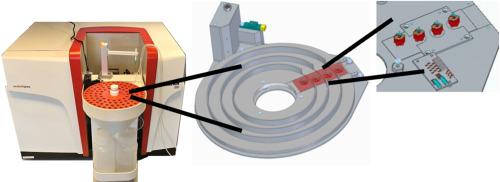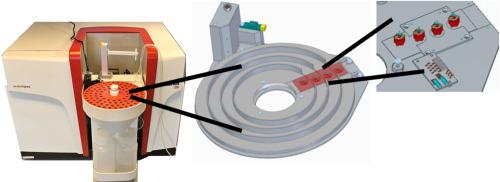Development of a fully automated slurry sampling introduction system for GF-AAS and its application for the determination of cadmium in different matrices
IF 5.7
2区 化学
Q1 CHEMISTRY, ANALYTICAL
引用次数: 0
Abstract
Background
Graphite Furnace-Atomic Absorption Spectrometry (GF-AAS) is a powerful technique for trace element analysis, offering high sensitivity and precision. However, its effectiveness is limited by sample preparation challenges for solid samples like soils and microplastics. Traditional methods include sample preparation, such as digestion, which is time-consuming and involves reagents, like acids, contributing to measurement uncertainty and higher carbon footprints. Slurry sampling allows direct analysis of suspensions, offering a more efficient alternative. However, maintaining suspension stability is challenging, requiring robust autosampler systems to streamline the process and enhance analytical performance.
Results
We present a novel autosampler extension for slurry sample introduction into GF-AAS. This system ensures suspension stability with a stirring device and closed vessels to prevent evaporation and contamination, incorporating a cooling unit to reduce solvent and analyte losses. It installs and removes in minutes without additional connections. Validation with cadmium analysis in BAM-U110 (Soil) and BAM-H010 (ABS) showed high reliability. For BAM-U110 (Soil), we achieved recovery rates of 94 % ± 13 % in water suspension. The recovery rate for BAM-H010 (ABS) was 104 % ± 11 % in acetonitrile suspension. These results demonstrate the system's robustness, versatility, and accuracy for different matrices.
Significance
The autosampler extension helps solve key problems in trace element analysis of solid samples, making the process faster and more accurate. It works well with complex materials, making it useful for areas like microplastic or nanoparticle analysis. This improvement also helps meet regulations for monitoring environmental and polymer samples, offering a reliable and flexible tool for high-throughput analysis with fewer errors.


为 GF-AAS 开发全自动泥浆采样引入系统及其在不同基质中镉测定中的应用
背景石墨炉原子吸收光谱法(GF-AAS)是一种强大的痕量元素分析技术,具有高灵敏度和高精确度。然而,对于土壤和微塑料等固体样品而言,其有效性受到样品制备难题的限制。传统方法包括样品制备(如消化),这不仅耗时,还涉及酸等试剂,从而导致测量的不确定性和更高的碳足迹。泥浆取样可以直接分析悬浮液,是一种更有效的替代方法。然而,保持悬浮液的稳定性是一项挑战,需要强大的自动进样器系统来简化流程并提高分析性能。该系统通过搅拌装置和封闭容器确保悬浮液的稳定性,以防止蒸发和污染,并配有冷却装置以减少溶剂和分析物的损失。安装和拆卸只需几分钟,无需额外连接。在 BAM-U110(土壤)和 BAM-H010(ABS)中进行的镉分析验证表明该系统具有很高的可靠性。对于 BAM-U110(土壤),我们在水悬浮液中实现了 94 % ± 13 % 的回收率。在乙腈悬浮液中,BAM-H010(ABS)的回收率为 104 % ± 11 %。这些结果证明了该系统在不同基质中的稳健性、多功能性和准确性。 重要意义 自动进样器扩展版有助于解决固体样品痕量元素分析中的关键问题,使分析过程更快、更准确。它能很好地处理复杂的材料,因此在微塑料或纳米粒子分析等领域非常有用。这一改进还有助于满足监测环境和聚合物样品的规定,为高通量分析提供可靠而灵活的工具,减少误差。
本文章由计算机程序翻译,如有差异,请以英文原文为准。
求助全文
约1分钟内获得全文
求助全文
来源期刊

Analytica Chimica Acta
化学-分析化学
CiteScore
10.40
自引率
6.50%
发文量
1081
审稿时长
38 days
期刊介绍:
Analytica Chimica Acta has an open access mirror journal Analytica Chimica Acta: X, sharing the same aims and scope, editorial team, submission system and rigorous peer review.
Analytica Chimica Acta provides a forum for the rapid publication of original research, and critical, comprehensive reviews dealing with all aspects of fundamental and applied modern analytical chemistry. The journal welcomes the submission of research papers which report studies concerning the development of new and significant analytical methodologies. In determining the suitability of submitted articles for publication, particular scrutiny will be placed on the degree of novelty and impact of the research and the extent to which it adds to the existing body of knowledge in analytical chemistry.
 求助内容:
求助内容: 应助结果提醒方式:
应助结果提醒方式:


